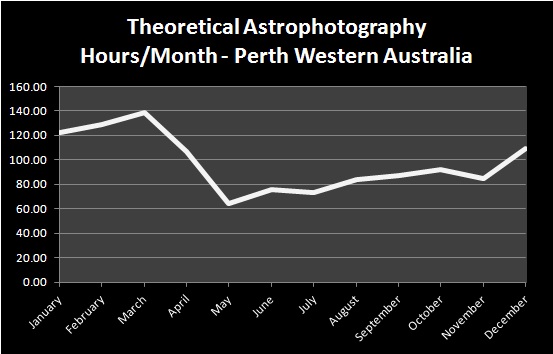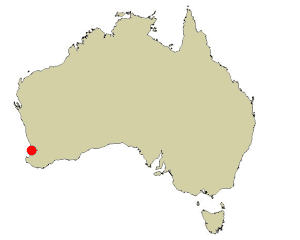Located in the outer suburbs of Perth, Western Australia, in the Southern Hemisphere, my observatory is well located for research and photographic activities. The observatory is particularly well suited to observing southern regions of the sky. I am always looking for new opportunities to expand the use of my observatory.
The observatory is well equipped for automated observations using either narrow field (10.6′ x 15.9′) or wide field (wide range of combinations available upon request). See later on this page for equipment information/statistics.
Past Usage and Experience
The observatory has previously been used for observations including:
- Occultation observations (including trans-neptunian objects Quoar and Pluto)
- Supernova searching.
- Comet nucleus rotation observations.
- Comet surveys.
- General astrophotography.

Location
Climate Information
| The following table outlines the climate information for Perth Western Australia which is most relevant for astronomical purposes. | ||||
| Month | Hours of Sunshine | Number of clear days | Number of Cloudy Days | Number of Dark Hours* |
| January | 11.6 | 18.0 | 4.6 | 6 hours 47 minutes |
| February | 11.0 | 16.0 | 4.8 | 8 hours 2 minutes |
| March | 9.5 | 15.5 | 6.0 | 8 hours 57 minutes |
| April | 8.2 | 10.7 | 10.0 | 9 hours 57 minutes |
| May | 6.8 | 6.0 | 6.1 | 10 hours 41 minutes |
| June | 6.0 | 6.9 | 12.7 | 11 hours 1 minute |
| July | 6.1 | 6.7 | 12.8 | 10 hours 53 minutes |
| August | 7.1 | 8.1 | 11.3 | 10 hours 19 minutes |
| September | 7.7 | 9.2 | 10.2 | 9 hours 26 minutes |
| October | 9.6 | 11.0 | 9.3 | 8 hours 21 minutes |
| November | 10.7 | 11.8 | 7.8 | 7 hours 11 minutes |
| December | 11.6 | 16.5 | 5.4 | 6 hours 37 minutes |
| * Number off dark hours is the number of hours between end of Twilight (dusk) and start of Twilight (dawn) per night (assuming the whole night is clear). Dark Hours calculated from TheSky6 Sun/Moon Report for the 15th day of each month based on 2011. * Climate data provided by Australian Government Bureau of Meteorology for Perth Airport station. | ||||
The above climate information can be used to calculate the maximum expected number of astronomical hours each month. This is the number of dark hours on clear days. The graph below shows the result:

Equipment Information & Capabilities
The observatory is eqiupped with two primary configurations, outlined below:
- 12″ SCT on Paramount ME
- Optical: 12″ SCT with native 3048mm focal length, usually used at 2180mm focal length.
- Mount: Paramount ME, fully automated.
- Camera: SBIG ST8-XME
- Filters: Astronomik Type-II LRGB
- 90mm Refractor on Paramount ME or Losmandy GM8
- Optical: 90mm refractor with native 690mm focal length, usually used at ~580mm focal length.
- Mount: Paramount ME or Losmandy GM-8
- Camera: SBIG ST-7XME or Canon DSLR cameras
Automation Capabilities
The observatory is capable of automated operation, particularly the 12″ telescope. Full automation is implemented including monitored weather and roof automation, allowing for maximum utilisation of clear nights. The observatory cannot be accessed and controlled remotely at this stage due in part to the limitation of initial synchronisation being required.
Visible Sky
The observatory has almost unobstructed views to the south, south-east and entire zenith area. The North, North-East and West are the most obstructed largely due to trees. The following illustrates the local horizon.

How to use the Observatory
The best way to utilise the capabilities of this observatory are either by:
- Requesting observations which the observatory operator (myself) will perform.
- Providing ready-made CCD Commander scripts which can then be executed by the observatory operator.
At this stage remote control of the observatory is not provided to external parties.
To request use of the observatory please contact myself to discuss what you require and options available to suit.
Cost
The cost (if there will be any) to you of using this observatory will depend upon the nature of your request request. Please contact myself to discuss what you require.
Enquiries
I welcome any enquiries regarding the use of my observatory, particularly for scientific research activities of which I can participate in. I am happy to spend time discussing your requirements with you to determine if the observatory is suitable for your tasks. Please contact myself to discuss what you require.
